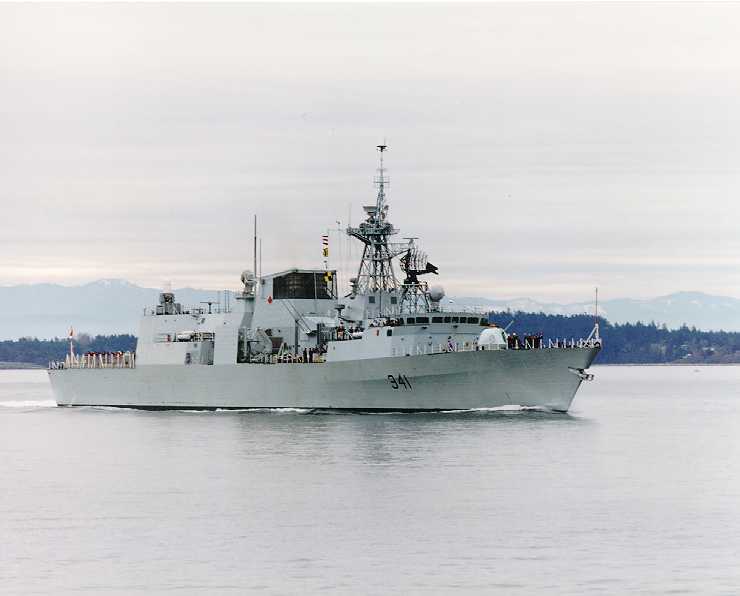More Ships Of The Canadian Navy Pacific Fleet
|
|

HMCS Ottawa
The Halifax Class ships are equipt with very sophisticated weapon and sensor systems,
including a rapid fire gun, torpedoes, long range surface to surface missles,
surface to air missles and navigational and fire control radars, sonar and electronic warfare systems.
The ships make extensive use of Canadian-designed computer technology
for integrated machinery control, communications and combat systems.
Each ship is capable of embarking one Sea King helocopter.
|
HMCS Protecteur
HMCS Protecteur is the Canadian Navy's only supply ship stationed on the Pacific Coast. Her role is to supply Canadian and Allied warships with fuel food and supplies thus enabling Canada's warships to remain at sea for longer peiods of time without having to return to port for fuel and supplies. Protecteur is a large vessel, displacing nearly five times the tonnage of one frigate. This allows her to carry enough provisions to supply a task force of six destroyers for six weeks without having to return to port for resupply. |
|
|
|
HMCS Regina
HMCS Regina is a multi-purpose Halifax Class Frigate
assigned to the Pacific Coast Navy of Canada.
Regina was constructed in Lauzon, Quebec Canada.
Commissioned on September 30, 1994 in Victoria B.C. |
HMCS Saskatoon
One of the Coast Guard ships of the Pacific coast, the Saskatoon's missions include Resource protection, fisheries control, counter terrorism disaster relief and scientific research. |
|
|
|
HMCS Vancouver
The Vancouver is seen here intercepting an oil tanker suspected
of smuggling oil out of Iraq. HMCS Vancouver is the second
of twelve Halifax class Frigates built under the Canadian Patrol Frigate Program.
One of the most advanced warships in the world, it was designed mainly
as a general purpose frigate, carrying extensive anti-submarine,
anti-surface and anti-air defence systems. |
HMCS Victoria
The Victoia/Upholders are modern, conventionally-powered boats with vastly evolved hydrodynamic features and advanced marine engineering systems, as well as better habitability and endurance. The boats are able to "snort" {through an extendable air-breather} while at periscope depth and can remain deeply submerged for extended periods of time. Operating depth is over 200 meters. The hulls are covered with 22,000 anechoic rubber tiles specifically designed to absorb sonar transmissions and make the submarine hard to detect. There is a five person diver lockout chamber in the fin. |
|
|
|
HMCS Whitehorse
Whitehorse was commissioned into Her Majesty's service on May 10,1997
in a traditional ceremony held in Esquimalt as part of the coastal defence.
The basic equiptment configuration includes surveillance radars,
40mm gun and .50 calibre weapons, a modern communications suite
and state of the art navigation systems. The Naval Reserve has been
tasked to carry out her mandate of maritime presence,
and all but two of her crew are from navy reserve. |
HMCS Yellowknife
Yellowknife is the 7th of 12 ships built under the Canadian Patrol Frigate Project of 1983. The current HMCS Yellowknife is the second warship to proudly carry that name.The Yellowknife was officially accepted into the navy on april 18, 1998 and then manned by her first official crew. |
|
|
|
|
|
|
|
|
HMCS Winnepeg
HMCS Winnepeg is one of five Halifax Class Frigates in the Pacific Fleet.
Boasting a complex Command and Control System interfaced to an impressive
array of sensors and weapons and a computer driven
Integrated Machinery Control System,
the Halifax Class are considered one of the most advanced
general purpose frigates in the world. |
|
|
|
|
Sea King Helocopter
A Sea King Helocopter guards the oil tanker, as a boarding party from the Vancouver
prepares to board and inspect the craft. Each Halifax Class Frigate can carry one helocopter.
The Tribal Class Destroyers can each carry two. |
|
|


